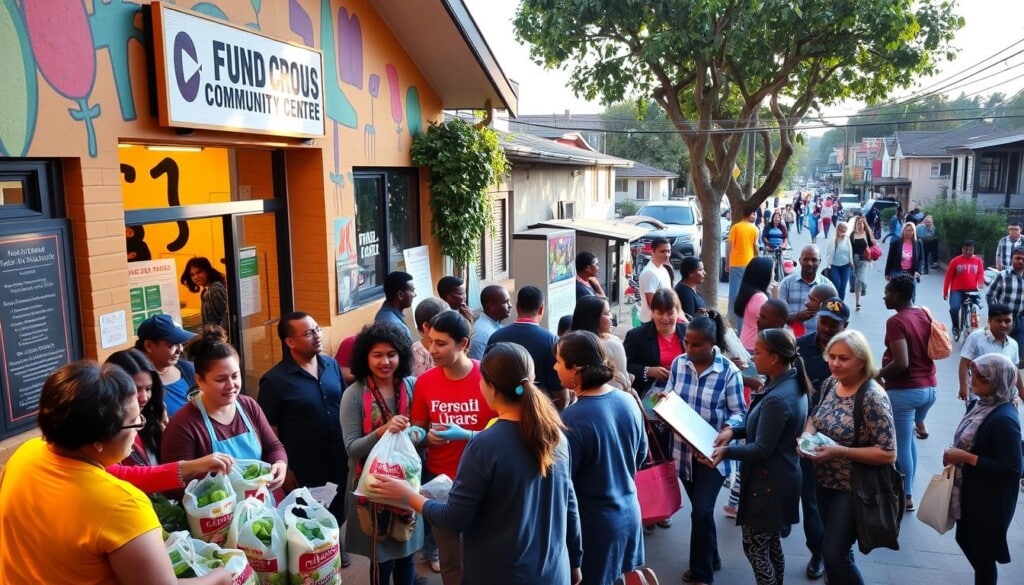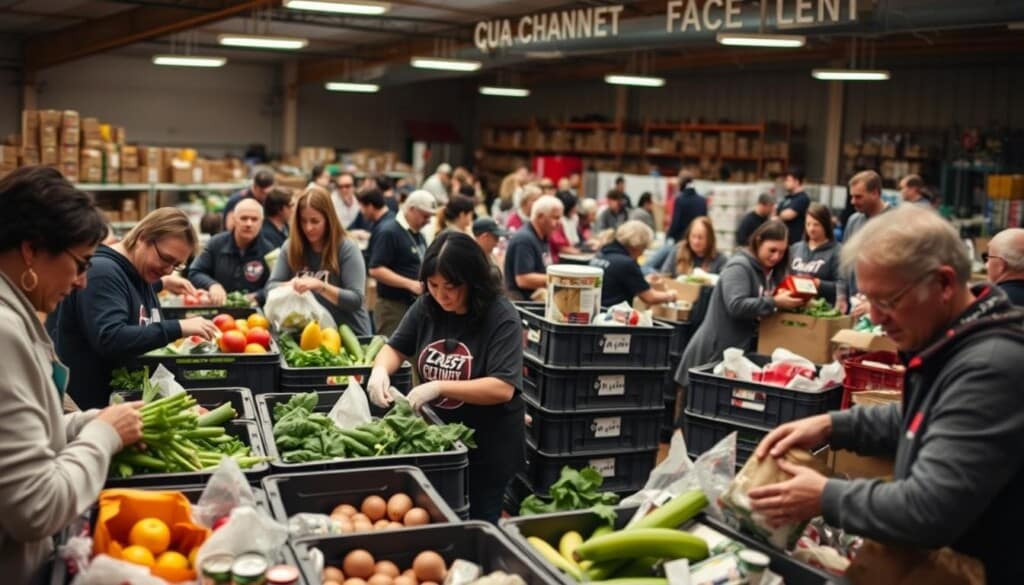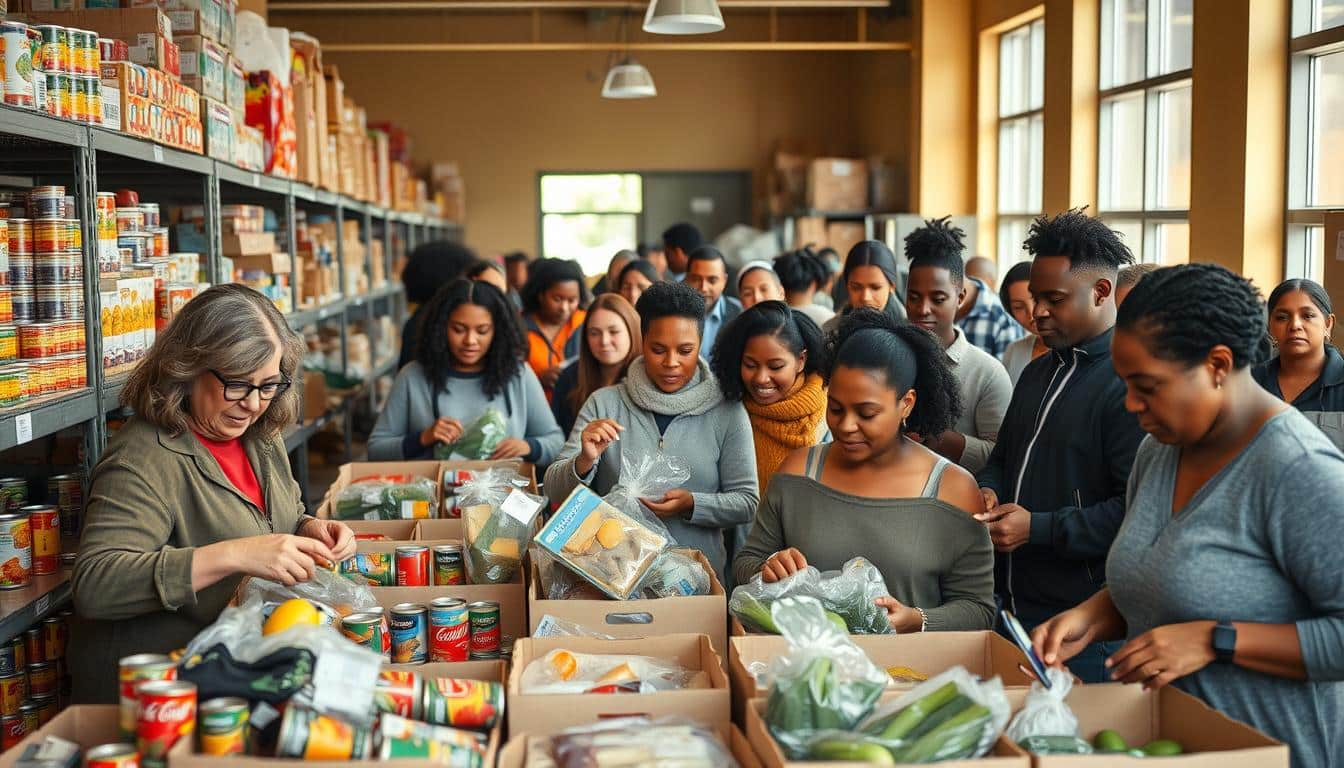Have you ever thought about how food banks help local communities? They are key in fighting hunger and supporting those in need. Food banks not only feed people but also build stronger communities through partnerships.
LocalZ is leading the way in making these services more visible. They create a network of kindness that strengthens our community. Let’s explore how food banks help and how you can support them.
Key Takeaways
- Food banks are essential in combating food insecurity in local communities.
- They provide critical support through various food assistance programs.
- Partnerships with organizations like LocalZ enhance community resilience.
- Food banks foster a culture of compassion and solidarity amongst residents.
- Engaging with food banks can help mobilize local resources effectively.
- Community involvement is key to the success of hunger relief efforts.
Understanding Food Banks: Their Purpose and Importance
Food banks are key for communities facing food shortages. They collect, store, and give out food to those in need. This helps families and individuals get the food they need, improving food security.
Food banks work with food makers, grocery stores, and others to get extra food. This way, they cut down on waste and help those who are most vulnerable.
What is a Food Bank?
A food bank is a central place for food help programs. They send food to pantries, shelters, and more. This makes sure people get healthy food when they need it most.
Food banks need donations and community help to keep going. They also help spread the word about food security, working with the government.
The Role of Food Banks in Local Communities
Food banks are important for local food security. They do more than just give out food. They teach about nutrition and budgeting to help families.
By working with food donation centers, they fight hunger together. Food banks make a big difference in neighborhoods. They help people become more self-sufficient and strong.
The Growing Need for Hunger Relief Efforts
Hunger relief efforts in the United States are more urgent than ever. Millions of families struggle to get enough to eat. This shows how critical it is to fight hunger and food insecurity.
Looking at the numbers helps us understand the scope of this problem. It shows how it affects communities all over the country.
Statistics on Food Insecurity in the U.S.
Recent data shows a sharp increase in food insecurity across the nation. Over 38 million Americans lacked steady access to food in the past year. Children are hit hard, with one in six not getting enough to eat.
This highlights the importance of community food resources. They play a key role in helping those in need.
Impact of the Pandemic on Hunger
The COVID-19 pandemic made hunger worse. Supply chain issues and economic problems made it hard for many to find food. This crisis showed the need for everyone to work together to help.
Food banks and organizations stepped up to meet the growing demand. They provided vital support to those struggling to get by.
LocalZ: Revolutionizing Community Engagement
LocalZ is a digital platform that changes how communities connect. It links local businesses with people who need services. This helps local services get noticed, which is key for good community talks.
Food banks and other programs get better at reaching out. This means they can help more people in need.
Enhancing Local Business Visibility
LocalZ makes local businesses more visible. They can reach people looking for help with food and other needs. This builds a stronger bond between businesses and the community.
Businesses get more exposure. This lets them join efforts to fight hunger more effectively.
Connecting Residents with Local Services
LocalZ makes it easy for people to find local services. Users can find food banks and other help they need. This boosts community spirit and helps local economies grow.

How LocalZ Supports Food Banks and Hunger Relief
LocalZ is a big help to food banks and hunger relief efforts. It doesn’t just give money; it also connects people in the community. This way, LocalZ makes local groups better at fighting hunger.
50% Business Listing Fee Contribution
LocalZ gives 50% of its business listing fees to help hunger relief. This money is a big help to these services. It lets them reach more people and meet the community’s changing needs.
Partnerships with Local Organizations
LocalZ teams up with nonprofits to make food banks stronger. These partnerships help food banks serve more people. LocalZ also helps local businesses and builds a strong network against hunger.
Finding Food Banks Using LocalZ
LocalZ makes it easy to find food banks and local services near you. Its simple design lets people quickly find food resources that fit their needs. This helps connect people with food banks, making it easier to get help.
Searching for Food Banks in Your Area
Just type in your zip code or city on LocalZ to find food banks. You’ll get a list of nearby food banks. This way, you can choose the best option for your needs. LocalZ also gives you the latest info on each food bank, so you don’t miss out.
Utilizing Community Resources Through LocalZ
LocalZ also points you to other community food resources. You’ll learn about their hours, services, and how to get involved. This helps build a stronger community by encouraging everyone to help with hunger relief.
Volunteering at Food Banks: Making a Difference
Volunteering at food banks lets you help fight hunger in your area. It also brings you joy by connecting with your community. By helping out, you not only tackle hunger but also build strong bonds with others.
People who volunteer often see real changes in their community. Their efforts make a big difference in the lives of those around them.
Benefits of Volunteering Locally
Volunteering locally does more than just help others. You learn new skills and understand the struggles of your neighbors. This experience grows your empathy and encourages others to help too.
By volunteering, you see how your actions can help fight hunger. This experience motivates you to keep making a difference.
Finding Volunteer Opportunities via LocalZ
LocalZ makes it easy to find volunteer spots. It connects you with local food banks and other services. This way, you can apply for roles easily and help your community more effectively.
Joining as a volunteer is a great way to help your community thrive. For more info, check out LocalZ’s community engagement platform. It offers many meaningful volunteer chances.

Success Stories: Food Banks in Action
Food banks are key in local communities, helping a lot through their programs. They tackle hunger and bring hope to many. Their work goes beyond just giving out food, showing a deep commitment to solving hunger issues.
Looking at local food banks shows their success in outreach programs. They address the root causes of hunger, like job loss and poor health access. Now, they offer job training, education, and health services, making a big difference in the community.
Case studies show the amazing work of these food banks. Some have teamed up with local businesses to build a better food system. This partnership helps those in need and looks forward to a brighter future. More on community involvement can be found here. These stories prove that food banks do more than feed people; they empower and strengthen communities.
How Businesses Can Contribute to Hunger Relief
Businesses play a key role in helping hunger relief efforts. By supporting local food banks, they build strong ties with their communities. They can make a big difference through sponsorship programs that focus on hunger relief.
By joining these programs, companies can boost their visibility. They also help tackle the serious issue of food insecurity.
Sponsorship Opportunities with Local Food Banks
Local businesses can help a lot by teaming up with food banks. They can give money, organize food drives, and run campaigns to raise awareness. These actions show their dedication to helping others and make a real difference.
Encouraging Employee Volunteerism
Getting employees to volunteer is another great way for businesses to help. By supporting local food banks, companies create a sense of teamwork and community spirit. This not only improves morale but also helps more people get the food they need.
The Role of Donations in Supporting Food Banks
Donations are key to food banks, helping them fight hunger in communities. They accept many types of donations, like non-perishable items and money. This support is vital for their work.
Getting the community involved is also important. It helps keep food shelves full and ready to meet local needs.

Types of Donations Accepted
Food banks take in many kinds of donations. Non-perishable items like canned goods and dried pasta are essential. Money donations also help, allowing food banks to buy fresh produce and other supplies.
This variety helps food banks meet the different needs of the communities they help.
How to Organize a Food Drive
Community members can help by organizing food drives. These events bring people together and show support for food banks. A good food drive needs careful planning and clear goals.
It’s important to know what items are needed. This helps make the drive more effective and supports food banks and their clients.
Community Affiliates: Empowering Local Engagement
Community affiliates are key in linking food banks with the people they help. They help by getting local support and making sure programs meet community needs. Being an affiliate means using local knowledge to fight hunger, building a strong bond between food banks and residents.
What it Means to Be a Community Affiliate
Being a community affiliate means helping food banks get more local support. It’s about joining the fight against hunger and spreading the word about help available. Affiliates find community needs and help fill them, making hunger programs more effective.
How to Become a Community Affiliate
Becoming a community affiliate is easy. Just apply if you want to help local food banks. This lets you use your skills to help, making the community stronger against hunger. Every new affiliate helps grow the support network, making a bigger difference.
The Future of Food Banks and Hunger Relief
The future of food banks is bright, thanks to new hunger relief innovations. These changes are making food distribution better. Now, food banks can serve their communities more effectively.
Transparency and efficiency in managing food are key. This ensures more help reaches those who need it most.
Innovations in Food Distribution
New tech is changing how food is distributed. Mobile food pantries are becoming more common. They bring food to areas that need it most.
Online platforms also help. They make it easier for people to ask for food and resources. This speeds up getting help to those in need.
Community-Driven Hunger Solutions
Community involvement is vital for food banks’ future. Local gardens and cooperative food projects are growing. These efforts cut down on food waste and help the environment.
By focusing on community solutions, food banks become stronger. They ensure everyone has access to food in a sustainable way.
Getting Involved: Your Steps Toward Supporting Local Hunger Relief
Rising hunger issues in communities call for action. Individuals can help by supporting local food banks. LocalZ is a platform that connects you with resources focused on hunger relief.
Join LocalZ Today
Joining LocalZ is a great first step. It connects you with local businesses that help with food assistance. This network boosts outreach and highlights local hunger-fighting efforts. You’ll also get access to valuable resources and community engagement opportunities.
Easy Steps to Support Local Food Banks
Donating food, volunteering, or organizing drives can make a big difference. These actions strengthen local food banks. With LocalZ, it’s easy to find ways to help, ensuring everyone gets the food they need.

